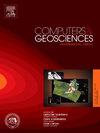EFKAN: A KAN-integrated neural operator for efficient magnetotelluric forward modeling
IF 4.4
2区 地球科学
Q1 COMPUTER SCIENCE, INTERDISCIPLINARY APPLICATIONS
引用次数: 0
Abstract
Forward modeling is the cornerstone of magnetotelluric (MT) inversion. Neural operators have been successfully applied to solve partial differential equations, demonstrating encouraging performance in rapid MT forward modeling. In particular, they can obtain the electromagnetic field at arbitrary locations and frequencies, which is meaningful for MT forward modeling. In conventional neural operators, the projection layers have been dominated by classical multi-layer perceptrons, which may reduce the precision of solution because they usually suffer from the disadvantages of multi-layer perceptrons, such as lack of interpretability, overfitting, etc. Therefore, to improve the accuracy of the MT forward modeling with neural operators, we integrate the Fourier neural operator with the Kolmogorov–Arnold network (KAN). Specifically, we adopt KAN as the trunk network instead of the classic multi-layer perceptrons to project the resistivity and phase, determined by the branch network-Fourier neural operator, to the desired locations and frequencies. Experimental results demonstrate that the proposed method can achieve high precision in obtaining apparent resistivity and phase at arbitrary frequencies and/or locations with rapid computational speed.
EFKAN:一种基于kan的高效大地电磁正演模拟神经算子
正演模拟是大地电磁反演的基础。神经算子已成功地应用于求解偏微分方程,在快速MT正演建模中表现出令人鼓舞的性能。特别是,它们可以获得任意位置和频率的电磁场,这对大地电磁法正演模拟具有重要意义。在传统的神经算子中,投影层一直被经典的多层感知器所主导,这可能会降低解的精度,因为它们通常具有多层感知器的缺点,如缺乏可解释性、过拟合等。因此,为了提高神经算子的MT正演建模精度,我们将傅里叶神经算子与Kolmogorov-Arnold网络(KAN)相结合。具体来说,我们采用KAN作为主干网络来代替经典的多层感知器,将分支网络-傅里叶神经算子确定的电阻率和相位投影到期望的位置和频率上。实验结果表明,该方法可以获得任意频率和任意位置的视电阻率和相位,计算速度快,精度高。
本文章由计算机程序翻译,如有差异,请以英文原文为准。
求助全文
约1分钟内获得全文
求助全文
来源期刊

Computers & Geosciences
地学-地球科学综合
CiteScore
9.30
自引率
6.80%
发文量
164
审稿时长
3.4 months
期刊介绍:
Computers & Geosciences publishes high impact, original research at the interface between Computer Sciences and Geosciences. Publications should apply modern computer science paradigms, whether computational or informatics-based, to address problems in the geosciences.
 求助内容:
求助内容: 应助结果提醒方式:
应助结果提醒方式:


